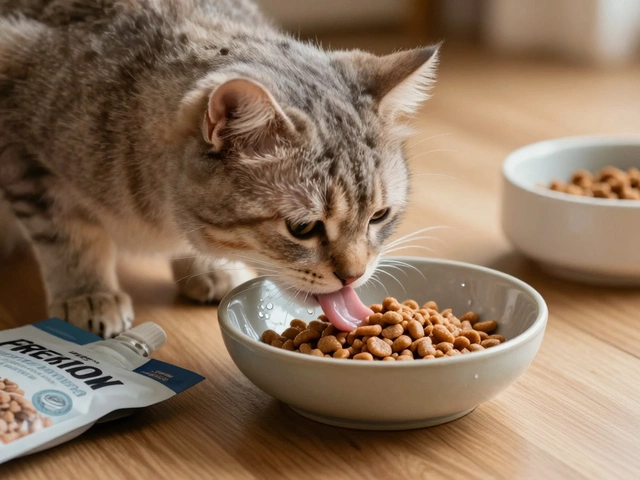
Thinking about pouring a little olive oil into your dog's bowl? This idea isn't as out there as it might sound. In fact, olive oil could be a simple way to give your furry friend some added health perks. But hang tight, there's more to this than just drizzling it over their kibble.
Olive oil is packed with antioxidants and healthy fats. It's the stuff that can make your dog's coat shine like a brand-new penny. But it's not just about looks. These healthy fats might also give their joints a helping hand, especially as they age.
Wondering if this is a daily thing? The key is balance. Olive oil can be beneficial every day, but it's all about the right amount. Pouring too much can upset your pup's stomach or add unnecessary calories. And nobody wants that.
While the benefits are great, keep an eye on your dog's reaction when you start this. It's like introducing any new food. Make sure they're cool with it and always, if in doubt, chat with your vet. Better safe than sorry, right?
- Why Olive Oil?
- Benefits of Olive Oil for Dogs
- Potential Risks and Considerations
- How to Introduce Olive Oil to Your Dog's Diet
- Signs You've Found the Right Balance
Why Olive Oil?
You might be thinking, "Why even consider olive oil for dogs in the first place?" Well, it's not just a cooking staple for humans. Olive oil can be a pretty handy staple for our canine companions too. But let's break down why it can be beneficial.
First off, olive oil is loaded with monounsaturated fats, which are the good kind of fats. These fats are known for their anti-inflammatory properties. Reducing inflammation is huge, especially for breeds prone to joint issues or older dogs showing signs of arthritis.
- Dog health gets a boost from antioxidants in olive oil, namely vitamin E. This vitamin is often championed for supporting immune function and keeping your dog's skin in top shape.
- Those healthy fats do more than shine up your dog's coat—they also help with skin issues. Dogs suffering from flaky skin might find relief with a dose of olive oil.
- Switching gears to internal benefits, these healthy fats can assist in maintaining a healthy weight by helping to carve a path for fat to burn more efficiently. Though, balance is key here!
If you're more of a numbers person, consider this: One tablespoon of olive oil contains about 120 calories and around 14 grams of fat. So while it’s beneficial, you'll want to measure its usage to avoid calorie overload.
Now, not all olive oil is the same. You’re searching for extra-virgin olive oil—the high-quality stuff. It's less processed, keeping more of those beneficial properties intact. So next time you’re in the aisle, you’ll know what label to reach for.
Benefits of Olive Oil for Dogs
You might be wondering what makes olive oil for dogs a thing. Well, let's break it down. Olive oil is packed with monounsaturated fats, which are the good kind. These fats can help manage cholesterol levels for us humans, and they do wonders for dogs too.
One standout benefit is the impact on your dog's coat. The antioxidants, especially vitamin E, contribute to skin health, reducing dryness and itchiness. A shiny, smooth coat is one of the first things you'll notice if your pup reacts well to olive oil.
"Incorporating olive oil into a dog's diet can lead to noticeable improvements in coat quality and skin health," says Dr. Emily Watson, a veterinarian specializing in canine nutrition.
Pet care enthusiasts also point out olive oil's potential in boosting immune function. Those healthy fats can assist in fighting off inflammation, which might be helpful if your pet struggles with joint discomfort.
Oh, and here's a tidbit for you: olive oil might even give your dog's brain a little boost. The fats in the oil are known to support cognitive health, so it could be a thoughtful addition if you've got an aging pooch showing signs of slowing down.
Looking at this in numbers might make more sense. Here's a quick snapshot of how your dog could benefit from olive oil:
| Nutrient | Benefit |
|---|---|
| Monounsaturated Fats | Improved coat condition |
| Antioxidants | Enhanced immune function |
| Vitamin E | Healthier skin |
But remember, while the benefits are cool, always keep a close eye on how your pet's reacting. Some pups might not vibe with it, and that's totally okay. Monitoring and adjusting is key. And like we always say, when in doubt, hit up your vet for advice.

Potential Risks and Considerations
Sure, olive oil for dogs sounds awesome, but hang on—there are potential risks to think about before making it a daily ritual. You wouldn't want your dog to have any tummy troubles, right?
The first thing to keep in mind is portion size. While olive oil is packed with good stuff, too much of it can lead to weight gain. It’s all those extra calories sneaking up, especially if your dog already has a full meal plan. So be mindful about how much you’re adding to their diet.
Next up is digestion. Some dogs might not jive well with olive oil, leading to an upset stomach or diarrhea. A little might be great, but if your pup starts having runs to the bathroom—or yard—it could be a sign to cut back.
If your dog has a specific health condition, that’s a good reason to pause and consult your vet. Certain problems, like pancreatitis, can be aggravated by too much fat, even if it’s from healthy sources like olive oil.
Check out this handy guide on how much olive oil might be just right for your dog:
| Dog Weight | Daily Olive Oil Amount |
|---|---|
| Under 20 lbs | 1/4 teaspoon |
| 20-50 lbs | 1/2 teaspoon |
| Over 50 lbs | 1 teaspoon |
Finally, freshness matters. Olive oil that’s gone bad can be harmful. Store it properly and check its expiry date—nothing worse than giving your pup something that's past its prime.
So, to sum up, introducing olive oil into your dog's world can be beneficial, but tread carefully. Keep an eye on your dog's behavior and health, and chat with your vet if something seems off. A little vigilance can make sure your dog gets the benefits without the hassle.
How to Introduce Olive Oil to Your Dog's Diet
So you're set on giving your furry pal some olive oil love every day. Awesome! But hold up. You don't just want to dump it in their bowl and call it a day. There's a smarter, safer approach to get it right.
First things first, start small. Think of it like any new addition to your dog's diet. You want to introduce it slowly to avoid any stomach surprises. Here's a simple way to get started:
- Start with a Tiny Amount: Begin by adding a 1/4 teaspoon to their food. It's all about seeing how they handle it first.
- Check for Allergies: Keep an eye on your dog after introducing olive oil. Look for signs like itching or diarrhea. If you notice anything odd, it might be time to pause and consult your vet.
- Adjust Gradually: If things go smoothly after a few days, you can work up to a full teaspoon for smaller dogs or up to a tablespoon for larger ones. Aim for a sweet spot rather than overdoing it.
Now, keep in mind the olive oil types. Extra virgin olive oil is usually the best choice for your pup due to its high antioxidant content. Also, store it properly to maintain its quality—away from heat and light.
Oh, and consistency is key! If you're adding olive oil to their meal, try to stick to a routine, like adding it once a day. But remember, every dog is different, so keep those communication lines open with your vet. They'll help make sure you're meeting your dog's needs without swinging too far one way or another.
Finally, if you're ever in doubt about mixing this dog health supplement into their meals, just think: "Would I eat something straight off the bat?" Probably not, right? Same goes for your dog.
With a careful approach, introducing olive oil can be a simple way to boost your dog's nutrient intake and overall well-being. Enjoy those joyful tail wags as they lap up their upgraded meal!

Signs You've Found the Right Balance
So, you’ve started adding that olive oil for dogs into your buddy’s meals, and you’re wondering, “Am I doing this right?” Figuring out the sweet spot is all about watching for certain clues in your pup's response.
First off, a noticeable sign is your dog's coat. If it’s looking shinier and smoother, you're on the right path. This means those healthy fats are doing their job. Plus, you might see less shedding than usual, which is always a win.
Next, take a look at their energy levels. With the right dose, your dog might seem a bit more buoyant or playful. Those omega-3 fatty acids are like little energy boosters.
It’s also crucial to keep an eye on their weight. While olive oil is healthy, it's also calorie-dense. Regular weigh-ins can help make sure you're not overdoing it and adding extra pounds.
Lastly, watch for any digestive changes. A happy belly often means you’ve nailed the balance. However, if there's an upset tummy or diarrhea, it might be a signal to scale back a bit.
- Shiny Coat: Means the healthy fats are effective.
- Increased Energy: Look for a bit more pep in their step.
- Weight Monitoring: Ensure stable weight prevents overfeeding.
- Smooth Digestion: No unusual upset means you're about right.
If any of these signs seem off, don't hesitate to adjust the amount or frequency. And if you're ever in doubt, phoning your vet for a quick check can be a good idea. Finding the perfect balance might take a little trial and error, but with careful observation, you’ll get there.





